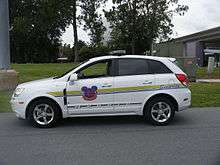Disney Global Security
Disney Global Security is a division of The Walt Disney Company responsible for workplace and guest safety, security and loss prevention at Disney resorts, theme parks, studios, corporate offices and Disney Cruise Line. This division also defines policies and programs for Disney's online presence and consumer products.[1]
Disney company policy does not allow employees to carry weapons, including security personnel.[2] Disney is exempted from Florida law which allows employees to carry weapons in their cars if they have a concealed weapons permit.[3]
Resorts and Cruise Line
Disney Global Security oversees the hotel and cruise line security, lifeguard hiring and training, and food safety program.
Disney trains and employs 1,200 lifeguards[1] to monitor pools located at its resorts, on its ships, and at the beaches of Castaway Cay.[4] Lifeguards are trained in water rescue, CPR, basic first aid, oxygen administration and the use of Automated external defibrillators.[1] Disney lifeguards have contributed to lifeguard training manuals and programs used nationwide.[5]
Disney's food safety program provides laboratory and on-site testing of food products throughout the delivery, preparation and service process. The Walt Disney World Safety and Health Department was recognized in 2001 for its food safety programs in place at resorts, theme parks and the cruise line by the International Association for Food Protection receiving the Black Pearl award.[6] The director there received the 2007 Lifetime Achievement Award for Leadership in Food Safety from NSF International.[7]
Theme parks
Disney's security personnel are generally dressed in typical security guard uniforms, though some of the personnel are dressed as tourists in plain clothes.[8] Since September 11, 2001, uniformed security has been stationed just outside each Disney park in Florida to search guests' bags as they enter the parks. Main Entrance formerly searched bags at the Disneyland Resort. Security now provides this service as of 2016. This also now occurs at Tokyo Disney Resort, Disneyland Resort Paris, and Hong Kong Disneyland Resort, outside the main entrance of all the parks.
Walt Disney World Resort

The land where Walt Disney World resides is part of the Reedy Creek Improvement District (RCID), a governing jurisdiction created in 1967 by the State of Florida at the request of Disney. RCID provides 911 services, fire, environmental protection, building code enforcement, utilities and road maintenance but does not provide law enforcement services. The approximately 800 security staff are instead considered employees of the Walt Disney Company. Arrests and citations are issued by the Florida Highway Patrol along with the Orange County and Osceola County sheriffs deputies who patrol the roads. Disney security does maintain a fleet of security vans equipped with flares, traffic cones, and chalk commonly used by police officers. These security personnel are charged with traffic control by the RCID and may only issue personnel violation notices to Disney and RCID employees, not the general public.[9][10]
Despite the appearance of the uniformed security personnel, they are not considered a legal law enforcement agency. Disney and The Reedy Creek Improvement District were sued for access to Disney Security records by Bob and Kathy Sipkema following the death of their son at the resort in 1994. The court characterized Disney security as a "night watchman" service not a law enforcement agency and was not subject to Florida's open records laws. An appeals court later upheld the lower court's ruling.[11]
In late 2015, Disney confirmed the addition of randomized secondary screenings and dogs trained to detect body-worn explosives within parks, in addition to metal detectors at entrances. It has also increased the number of uniformed security personnel at Disney World and Disneyland properties.[12]
Disney Security personnel in Florida have investigated traffic accidents and issued accident reports. The forms used by Disney Security may be confused with official, government forms by some.
The Orange County Sheriff maintains an office on Disney property, but this is primarily to process guests accused of shoplifting by Disney security personnel.[13]
See also
Incidents at Walt Disney World
References
- 1 2 3 "Report on Safety" (PDF). The Walt Disney Company. Retrieved 2009-03-21.
- ↑ Smith, Roger (January 12, 1981). "Disneyland Security Officers Use Psychology, Not Guns". Los Angeles Times.
- ↑ "Security Guard Plans To Challenge Disney By Bringing Gun To Work". July 3, 2008. Retrieved 2009-03-21.
- ↑ Miller, Laura Lea (2007). Walt Disney World and Orlando for Dummies. Wiley-Interscience. p. 248. ISBN 0-470-11274-3.
- ↑ Ellis, Jeff; National Safety Council (2000). National Pool and Waterpark Lifeguard Training. Jones & Bartlett Publishers. ISBN 0-7637-1733-9.
- ↑ "Past Awardees". International Association for Food Protection.
- ↑ "NSF International Announces Recipients of the 2007 Food Safety Leadership Awards". National Sanitation Foundation.
- ↑ Fjellman, Stephen M. (1992). Vinyl Leaves: Walt Disney World and America. Westview Press. p. 218. ISBN 0-8133-1472-0.
- ↑ Foglesong, Richard E. (2003). Married to the Mouse. Yale University Press,. pp. 69,139. ISBN 0-300-09828-6.
- ↑ Southern Reporter. Second Series. Alabama. Supreme Court, Alabama. Court of Appeals, Florida. Supreme Court, Louisiana. Courts of Appeal, Louisiana. Supreme Court, Florida. District Court of Appeals, Mississippi. Supreme Court. West Pub. Co.
|first1=missing|last1=in Authors list (help) - ↑ Pastor, James F. (2006). Security Law and Methods. Butterworth-Heinemann,. pp. 505–512. ISBN 0-7506-7994-8.
- ↑ Louissant, Moise. "The Walt Disney Company: A Case Study in Private Security Trends". Fast Guard Service. Retrieved 29 January 2016.
- ↑ Schweizer, Peter; Rochelle Schweizer (1998). Disney: The Mouse Betrayed : Greed, Corruption, and Children at Risk. Regnery Publishing. pp. 65–68. ISBN 0-89526-387-4.